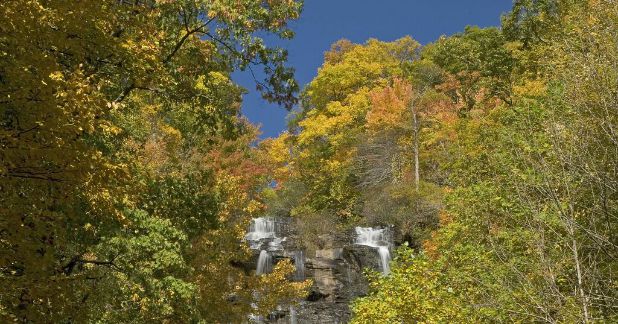Fall’s cool, crisp air welcomes visitors to take advantage of the outdoors, and Georgia State Parks is the place to play. Whether hiking or paddling, camping or glamping, or spotting wildlife or changing leaves, follow the compass directions and you’ll find every Georgia State Park has plenty to offer to families, friends and solos no matter what part of Georgia’s backyard you’re in.
North:
The North Georgia Mountains are painted with a myriad of oranges, reds and golds, and leaf colors peak in late October through early November. The prime leaf-watching spots in this region are Amicalola Falls, Black Rock Mountain, Cloudland Canyon, Fort Mountain, Moccasin Creek, Tallulah Gorge, Unicoi and Vogel. Hike or bike the trails in these parks to beautiful overlooks that offer sweeping views of the Chattahoochee National Forest.
Georgia’s highest state park, Black Rock, sits at 3,640 feet elevation, and hikers can trek on the 2.2 mile Tennessee Rock trail to the overlook, where on clear days you can see Georgia to the south and North Carolina to the north. Visit Tallulah Gorge during the first three weekends of November to watch white water kayakers as they take on Georgia’s most difficult rapids during the bi-annual dam release. At Cloudland Canyon, the Sitton Gulch Trail takes you by beautiful waterfalls on Daniel Creek, and down 1,200 stair steps, offering a unique perspective of the gorge’s color from below. Many of the 11 trails from Georgia State Park’s Muddy Spokes Club are located in the mountains, and mountain biking is the fastest way to get to scenic overlooks.
Enjoy the comforts of cabins with fireplaces and heated spaces during the colder evenings. At Fort Mountain and Vogel, several cabins are newly renovated to reflect a more modern, spacious feel. Vogel guests can enjoy the luxuries of Wi-Fi and flat screen televisions, while still spending a night nestled in the wilderness.
South:
In the South, fall is the time to take advantage of a lower-humidity, bug-free climate, where the sunshine beckons you to spend your daylight hours outdoors. Wildlife viewing is prime down here, where visitors can walk the birding trails or paddle the isolated waterways at Reed Bingham, Skidaway Island, and Stephen C. Foster.
Reed Bingham’s kayak/canoe water trail weaves through the hidden sections of the park, and paddlers can catch glimpses of deer and gators along the banks, and buzzards high in the trees. On land, gopher tortoises mosey down the park’s trails. The short hikes at Skidaway Island take hikers by salt marshes and maritime forests, and tidal creeks are populated with shrimp, fiddler crabs, minnows and oysters. Stephen C. Foster is the gateway to the Okefenokee Swamp, and a paddle under the moss-laced trees is the perfect scouting opportunity to see wildlife such as alligators, storks, deer and raccoons.
Camping in the South is most enjoyed in fall’s cool temperatures. Take advantage of Stephen C. Foster’s location in the Deep South makes it one of the darkest spots in the state to stargaze. Pitch a tent in the campground and find a clearing to see the dark sky illuminated with constellations. For a more comfortable experience, Skidaway Island’s camper cabins allow guests to stay overnight in the park with the shelter of four walls and a roof. These three camper cabins have the look of a luxe ranch house, with brand new hardwood floors and an airy, open living area.
East & West:
The glory of Georgia is that fall color arrives later in the season just south of Atlanta in the East and West. Many visitors to these parks are surprised to find rolling mountains and hardwood forests bursting with golden color. Fall leaves peak as late as Thanksgiving at state parks such F.D. Roosevelt, Hard Labor Creek, and Sweetwater Creek.
For a different perspective, enjoy the season by kayak or on horseback. Paddling on rivers or lakes, the water mirrors the trees above. Fish out of the lakes at Mistletoe, known as one of the prime spots to find bass. Hard Labor Creek’s 22 miles of equestrian trails take riders through creek bottoms and across quarries. At A.H. Stephens, three separate loops tally up to 19 miles of secluded trails under the shaded hardwood forests.
When you plan your stay for the night, choose between glamping or camping. At Sweetwater Creek, the Georgia State Parks’ newest yurt village will open in late August. The yurts sleep six people and include an in-unit heater, a bunk bed, futon sofa and futon chair, as well as a picnic area and grill – all to make your stay in a state park a fun experience in nature. The most rugged overnight experience is at Chattahoochee Bend, where visitors can paddle-in to their own private campsite on the river banks within the state park.
Fall is prime time to stay the night at Georgia State Parks, offering camping, cabins and other accommodations. These are often booked months in advance for peak fall season, so visitors are encouraged to make reservations as soon as possible to snag the best spots. As you plan your trip, keep an eye out for organized fall activities such as guided hikes, paddles, and festivals. Please visit the Georgia State Parks event calendar at GeorgiaStateParks.org/events.









Leave a Comment
You must be logged in to post a comment.